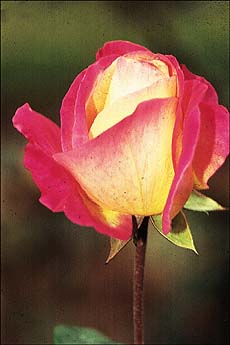 The rose must get full sun
exposure because under partial or full shade conditions,
you cannot expect the best out of it, advises Satish
Narula The rose must get full sun
exposure because under partial or full shade conditions,
you cannot expect the best out of it, advises Satish
Narula
A healthy rose
ARE you disappointed with your
roses? Do they survive for a short span and then decline?
There is `no uniform rose bed in your garden. The blooms
show burnt margins, are out of shape, fail to open or are
of poor quality. Are you planning to get rid of them?
Don’t. The problems, most of these, are
self-created. Get rid of them. You will be rewarded.
There is nothing wrong
with the climate so far as growing roses is concerned.
And if you find any damage to blooms due to winter frost
or extreme cold conditions, then you can skip it by
manipulating the pruning time. Do not strictly follow the
book which says pruning should be done in October. In
fact the plant takes about 60 days after pruning to
bloom.
The October pruning leads
to flowering same time in the last week of December, the
time when the danger of frost is maximum. In case of
exposure either the blooms fail to open or have burnt
(blackend) margins of the petals. Why not then advance
the pruning time by a few days? Do it this time and see
the effect. Do not forget to smear the cut-end the same
disinfectant like Bordeaux paste and Bordeaux paint. If
you do not have any of these handy, then make a slurry of
Blitox powder and cover the wound.
There is something more to
the traditional way of (mis)handling roses. Exposing of
roots is associated with rose pruning. This is to give
manure and fertilisers and to expose the roots to sun.
Nothing could be more injurious to rose plants than this.
Had there been a need for exposure to sun, the mother
nature would have, on its own, provided the roots at the
top of the plant. What happens, in fact, is that the
feeders, that are confined to the upper few inches of the
soil, get damaged and the plant starts declining, dying
one by one over a period of time. Repeated replacements
in a bed lead to variable age, ultimately leading to no
uniformity of growth and size, thus killing the effect.
There is no need to expose the roots and do spoon-feeding
with fertilisers. All the commercial fertilisers break
down in the soil and are taken up by the plants on their
own. These are just to be mixed with the upper soil layer
all around, a few inches away from the main stem.
The third most important
aspect is protection against insect and pests. When the
rose buds fail to open or when the opened bloom has very
short life, you can be sure that other than the cold
injury, as explained earlier, it is the insect attack.
Aphids are active during
December to February. Their young ones, the nymphs,
congregate at the base of the unopened buds and suck sap.
The affected buds either fail to open or give distorted
bloom. In the folds of petals of partially opened
flowers, there hide tiny thrips and aphids whichsuck the
sap and distort the bloom. Both these insects can be
controlled by spraying rogor (Dimethoate) or metasystox.
Red scales appear like pox
marks. These are in fact waxy coverings under which
insects live. They feed under this protective covering
and at times cause mortality of the plant. The red scales
attack occurs in February-March. Under ‘samall
garden’ conditions this pest can be controlled by
application of rogor etc. dissolved in water and applied
with any used toothbrush by rubbing the stems with it.
Application of phorate ganules, one tablespoonful thrice
i.e. at the time of pruning, one month thereafter and
again one month after the second application will
effectively control not only the scales but other insects
too.
A close look at the leaves
and buds may reveal the presence of white powdery mass,
the powdery mildew. The young emerging buds are also
completely covered with it. The leaves curl up and the
buds fail to open. Spraying wettable sulphur or
karathane, control it. Die-back kill the plants from tip
downwards. It usually sets in after pruning. If not
stopped in time, it may kill the whole plant, especially
in the initial stage. Black spot is also an important
disease. It is a fungal disease that causes premature
defoliation. Spraying captan helps. Destruction of
infected leaves is also important.
Another important fact:
The rose needs full sun exposure. Under partial or full
shade conditions you cannot expect the best out of it.
|

